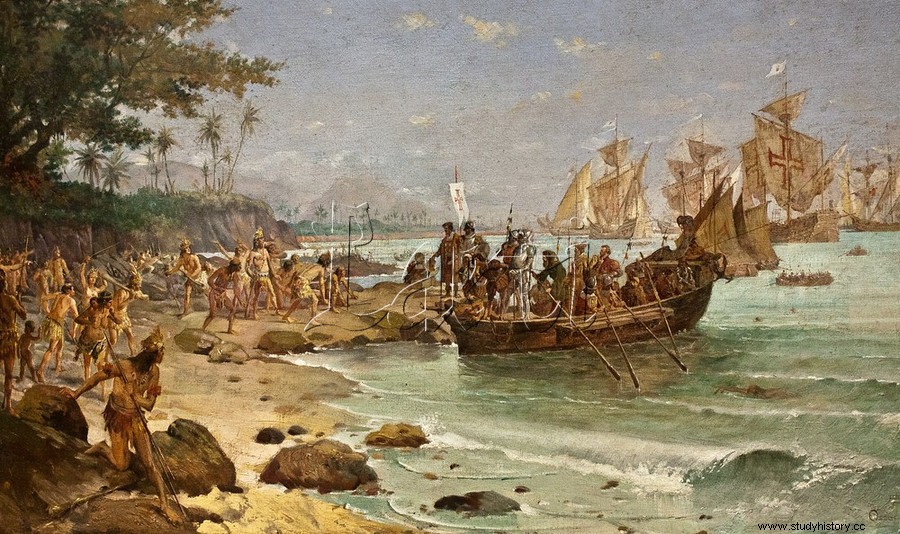Today, the appearance of a comet in the sky is quite an astronomical spectacle. Before it was a symptom and omen of adversity. The expedition of Pedro Álvares Cabral he was able to verify it. He left Portugal on March 9, 1500, made up of 13 ships (10 carracks and three caravels). Bad number, some of the 1,200 men he was transporting must have thought, including well-trained soldiers in warfare. Luis de Camoens was in the fleet as a volunteer , which he was later to illustrate in his poem Os Lusiadas the adventurous spirit of his companions.

Pedro Alvares Cabral
Cabral was a member of the Order of Christ, he was 33 years old and he knew that this was his great opportunity. From the very beginning, this expedition was prone to disaster and all kinds of incidents and misfortunes arose. One of them even had a happy ending, since they were diverted by a storm to the west, which caused the accidental sighting of the coast of Brazil, on April 22, 1500, claiming this discovery for their country (today it has been put doubt that it was so "accidental"). On May 2, the squad loses sight of the Brazilian coast and that's when the biggest problems begin to arise. The most serious mishap occurred when they were already reaching the end of the African continent and anchored in the waters of the South Atlantic.

Disembarkation of Cabral in Porto Seguro (Brazil)
According to a Portuguese chronicle, on the twelfth day of May in that area they see a bright comet appear in the southern sky with a long tail, and it remained there for several consecutive nights, pointing its head towards the Cape of Good Hope. These 15th century sailors, so full of superstitions, gave them the impression that this aerial phenomenon was a bad omen, common in those times. And they were right. As soon as the comet had disappeared from the sky, the weather conditions changed. Strangely, the wind died, but only to return with hurricane force of such intensity that it scattered the entire fleet. The text collected from the Relaçao do Piloto anônimo (1500), chapter LXVII - «Storm of a great tao that III naus will be lost», from the work O descobrimento do Brasil of T.O. Marcondes de Souza (1956) says the following, once translated from Portuguese:
Item. On the other day, which was May 2 of that year, the navy unfurled sails along the road to go around the Cape of Good Hope, or which road would be in the Gulf of the Sea, more than MCC leagues, which is four miles. per league And on the 12th day of that month, walking along our path, a comet appeared to us in the direction of Arabia with a very long tail, which appeared continuously for eight or better ten nights.
The Valencian chronicler Martí de Viciana amplifies this information a little more in his Third Book of the Chronicle of the Incredible and crowned city of Valencia of his kingdom (1563) when he adds:«And on the XXIII of that month the rough and furious sea rose, which was very frightening, also because by day the water had the color of fish and by night it was fire». The true fact is that four ships sank with their entire crew, one of them captained by Bartolomeu Dias (the one who supposedly knew this most dangerous cape best; not in vain was he the discoverer of Cabo de las Tormentas, which years later was called Cape Good Hope not to scare). One ship ran aground and caught fire and another became separated from the fleet and is presumed to have sunk. Cabral finally managed to reach Calicut (west coast of India) and after a short time he fell out with the local kings and had to rush to sea chased by arrows and bombard the city.
He would arrive in Lisbon on July 31, 1501 with only five ships fully loaded, two empty and six lost out of the thirteen ships with which he had set out. Decimated in men but with a fortune in spices and the "official" geographical discoveries of Brazil and Madagascar, something is something. The bad thing is that although said discovery has been attributed to him, it is known that the Spaniards Vicente Yáñez Pinzón were in those lands before. (in January of that year) and Diego de Lepe (in February), reaching the mouth of the Amazon, but they did not claim it for the crown of Castile. Why? It is due to the Treaty of Tordesillas (1494), by which the two discovering powers of the time, Spain and Portugal, shared the areas of influence by setting a demarcation line in one of the meridians (located 370 leagues west of the islands of Cape Verde) falling the territories of the east of Brazil under the Portuguese orbit. Hush. And here peace and then glory that then everything is known, including the comet.
